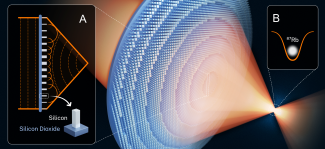JILA Fellow Cindy Regal and her team, along with researchers at the National Institute of Standards and Technology (NIST), have for the first time demonstrated that they can trap single atoms using a novel miniaturized version of “optical tweezers” — a system that grabs atoms using a laser beam as chopsticks.
In the new design, instead of typical lenses, the team used unconventional optics — a square glass wafer about 4 millimeters in length imprinted with millions of pillars only a few hundreds of nanometers (billionths of a meter) in height that collectively act as tiny lenses. These imprinted surfaces, dubbed metasurfaces, focus laser light to trap, manipulate and image individual atoms within a vapor. The metasurfaces can operate in the vacuum where the cloud of trapped atoms is located, unlike ordinary optical tweezers.
You can read the full article from NIST at this link.



 The Physics Frontiers Centers (PFC) program supports university-based centers and institutes where the collective efforts of a larger group of individuals can enable transformational advances in the most promising research areas. The program is designed to foster major breakthroughs at the intellectual frontiers of physics by providing needed resources such as combinations of talents, skills, disciplines, and/or specialized infrastructure, not usually available to individual investigators or small groups, in an environment in which the collective efforts of the larger group can be shown to be seminal to promoting significant progress in the science and the education of students. PFCs also include creative, substantive activities aimed at enhancing education, broadening participation of traditionally underrepresented groups, and outreach to the scientific community and general public.
The Physics Frontiers Centers (PFC) program supports university-based centers and institutes where the collective efforts of a larger group of individuals can enable transformational advances in the most promising research areas. The program is designed to foster major breakthroughs at the intellectual frontiers of physics by providing needed resources such as combinations of talents, skills, disciplines, and/or specialized infrastructure, not usually available to individual investigators or small groups, in an environment in which the collective efforts of the larger group can be shown to be seminal to promoting significant progress in the science and the education of students. PFCs also include creative, substantive activities aimed at enhancing education, broadening participation of traditionally underrepresented groups, and outreach to the scientific community and general public.